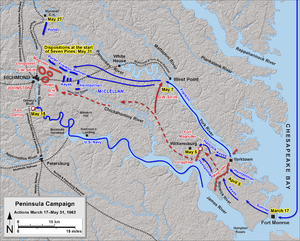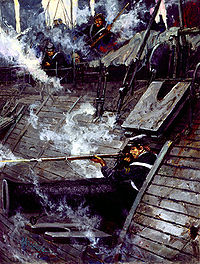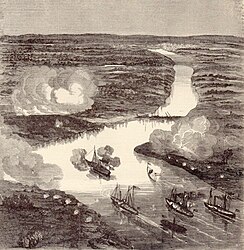The Battle of Drewry's Bluff, also known as the Battle of Fort Darling, or Fort Drewry, took place on May 15, 1862, in Chesterfield County, Virginia, as part of the Peninsula Campaign of the American Civil War. Five Union Navy warships, including the ironclads USS Monitor and Galena, steamed up the James River to test the defenses of Richmond, Virginia, the Confederate capital. They encountered submerged obstacles and deadly accurate fire from the batteries of Fort Darling at Drewry's Bluff, which inflicted severe damage on Galena. The Union Navy was forced to turn back.
Background[]

Peninsula Campaign, map of events up to the Battle of Seven Pines
In the spring of 1862, Union Major General George B. McClellan launched an amphibious operation against Richmond by landing troops at Fort Monroe and then marching northwest up the Virginia Peninsula. After the fall of Yorktown and the withdrawal of General Joseph E. Johnston's army up the Peninsula, only the Confederate Navy ironclad CSS Virginia prevented Union occupation of the lower James River and Norfolk. When the Confederate garrison at Norfolk was evacuated by Maj. Gen. Benjamin Huger on May 10, Flag Officer Josiah Tattnall knew that he could not navigate Virginia through the shallow stretches of the James River toward Richmond, so she was scuttled on May 11 off Craney Island to prevent her capture. This opened the James River at Hampton Roads to Federal gunboats.
The only obstacle that protected Richmond from a river approach was Fort Darling on Drewry's Bluff, overlooking a sharp bend on the river 7 mi (11 km) down river from the city. The Confederate defenders, including marines, sailors, and soldiers, were supervised by navy Commander Ebenezer Farrand and by army Captain Augustus H. Drewry (the owner of the property that bore his name) of the Southside Heavy Artillery.[2] The eight cannons in the fort, including field artillery pieces and five naval guns, some salvaged from the Virginia, commanded the river for miles in both directions. Guns from CSS Patrick Henry, including an 8 in (200 mm) smoothbore, were just upriver and sharpshooters gathered on the river banks. An underwater obstruction of sunken steamers, pilings, debris, and other vessels connected by chains was placed just below the bluff, making it difficult for vessels to maneuver in the narrow river.[3]
Battle[]

Cpl John F. Mackie firing from the USS Galena

Confederate gun at Battery Dantzler, Drewry's Bluff.
On May 15, a detachment of the U.S. Navy's North Atlantic Blockading Squadron, under the command of Commander John Rodgers steamed up the James River from Fort Monroe to test the Richmond defenses. The flotilla consisted of the ironclad gunboats USS Monitor (commanded by Lieutenant William N. Jeffers) and Galena (the flagship), the screw gunship Aroostook, the side-wheeler Port Royal, and the twin-screw ironclad Naugatuck.[4]
At 07:45, Galena closed to within 600 yd (550 m) of the fort and anchored, but before Rodgers could open fire, two Confederate rounds pierced the lightly-armored vessel. The battle lasted over three hours and during that time, Galena remained almost stationary and took 45 hits. Her crew reported casualties of 14 dead or mortally wounded and 10 injured. Monitor was a frequent target, but her heavier armor withstood the blows. Unfortunately for her crew, her guns could not elevate high enough to fire on the Confederate batteries, 110 ft (34 m) above the river. Naugatuck withdrew when her 100-pounder Parrott rifle exploded. The two wooden gunboats remained safely out of range of the big guns, but the captain of Port Royal was wounded by a sharpshooter. Around 11:00, the Union ships withdrew to City Point.[5]
Aftermath[]
During the battle, Corporal John F. Mackie became the first Marine to earn the Medal of Honor.
The massive fort on Drewry's Bluff had blunted the Union advance just 7 mi (11 km) short of the Confederate capital, at a loss of seven Confederates killed and eight wounded.[6] Richmond remained safe. Rodgers reported to McClellan that it was feasible for the navy to land troops as close as 10 mi (16 km) from Richmond. Some amateur researchers think the Union Army never took advantage of this observation,[7] yet the entire purpose of the expedition was to obtain such information.
The area saw action again during the Siege of Petersburg. The Army of the James landed on May 5, 1864, at Bermuda Hundred, a neck of land north of City Point at the confluence of the James and Appomattox Rivers, only 15 miles (25 km) south of Richmond. The army marched overland, advancing within three miles (5 km) of Drewry's Bluff by May 9. From a tactical perspective, Bermuda Hundred allowed a complete amphibious landing with less likelihood of counterattack than a landing five miles closer to Drewry's Bluff and Fort Darling.
Notes[]
References[]
- Eicher, David J. The Longest Night: A Military History of the Civil War. New York: Simon & Schuster, 2001. ISBN 0-684-84944-5.
- Kennedy, Frances H., ed. The Civil War Battlefield Guide. 2nd ed. Boston: Houghton Mifflin Co., 1998. ISBN 0-395-74012-6.
- Salmon, John S. The Official Virginia Civil War Battlefield Guide. Mechanicsburg, PA: Stackpole Books, 2001. ISBN 0-8117-2868-4.
- Sears, Stephen W. To the Gates of Richmond: The Peninsula Campaign. Ticknor and Fields, 1992. ISBN 0-89919-790-6.
- National Park Service battle description
- CWSAC Report Update
External links[]
| Wikimedia Commons has media related to Battle of Drewry's Bluff. |
Coordinates: 37°25′16″N 77°25′22″W / 37.4211°N 77.4229°W
The original article can be found at Battle of Drewry's Bluff and the edit history here.
